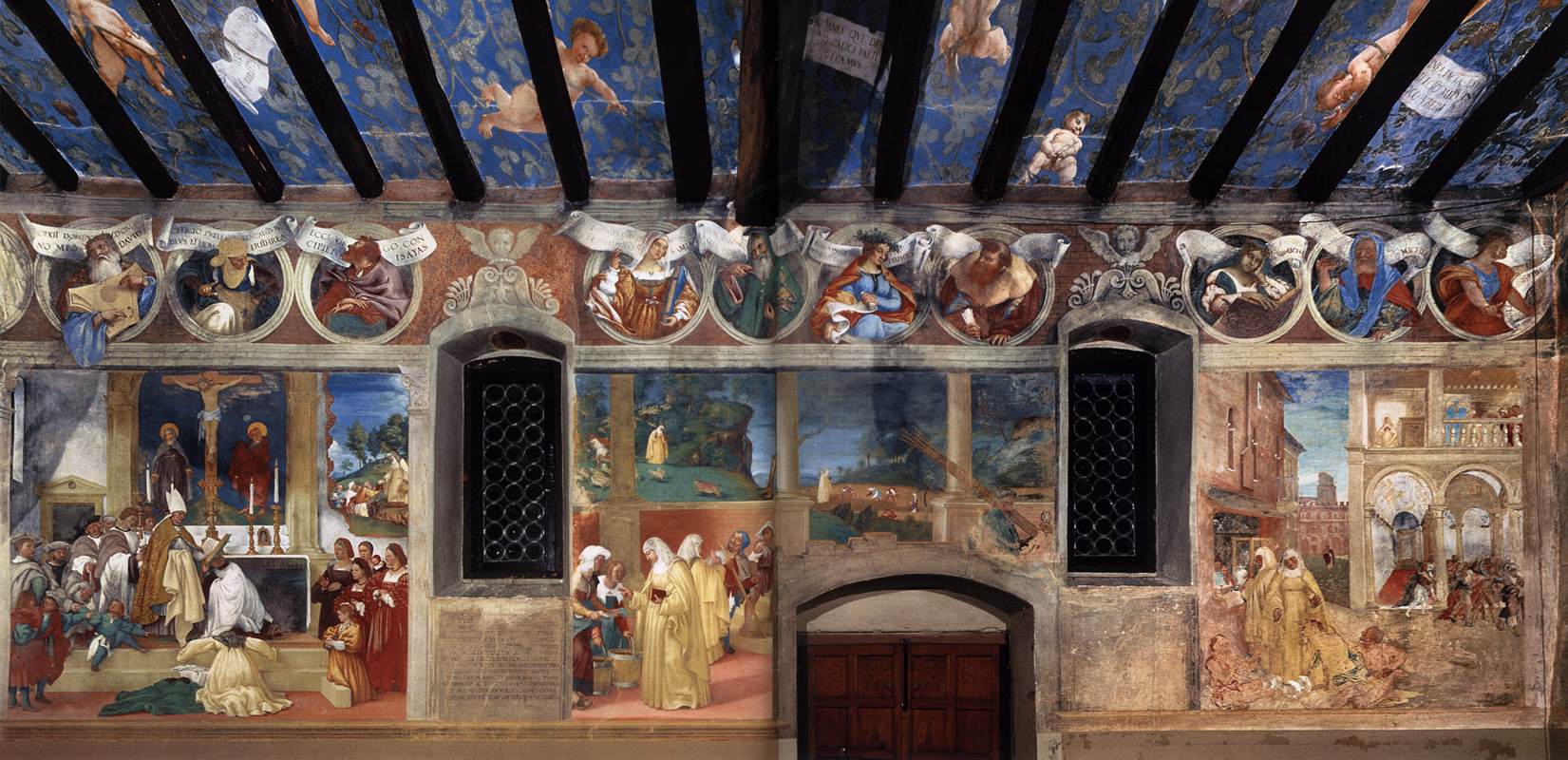Lorenzo Lotto, The Legend of St. Brigid

1523-24
Fresco
Suardi Chapel, Trescore, Italy
The panel on the left portrays St. Brigid's taking the veil – that is, her consecration as a nun. The bishop is identified in one source as St. Mel and in another as a St. Maccaille.1 On the floor at Brigid's left are her former clothes; on the step above them is the white veil she will be wearing. White is traditionally St. Brigid's color, so the yellow habit she wears throughout the fresco scenes is a bit puzzling.2
Above the group of women on the right of this panel we see painted a scene of Brigid distributing milk to the poor. Her veil is not white but gray, a reference to the fact that this episode in her life occurred before her consecration.3
The middle panel gives us three scenes with four episodes from the life of St. Brigid. In the lower foreground, she blesses food and water, turning the water into beer.4 Behind her is a further episode in which she cures a blind man. The figure in rags behind the blind man is the "leprosus" who guided him to the saint.5 (The texts use leprosus indiscriminately for any poor person who is also ailing in some way.)
In the upper left of the middle panel, Brigid blesses a wild boar who was about to attack a flock (of pigs in the story, here a flock of sheep). Above her is a further scene in which the boar, having been blessed, grazes peacefully among the other animals.6
In the panel's upper right scene, the saint calms a storm that was threatening to ruin the harvest.7 In a nice touch of Renaissance perspective, Lotto places a well-satisfied harvester in the foreground with a big sheaf on his shoulder.
The episodes in the right panel are most likely drawn from some specific text. In the Suardi Chapel frescoes Lotto tends to follow his written source faithfully.8 However, I have yet to find a Life that corresponds to the scenes shown. In the foreground of the street scene, the saint takes a glass pitcher of milk from someone at a window. At her feet, two poor men have taken the pitcher, which is now empty (and perhaps broken – it is hard to tell from the photograph).
Behind her, a number of what seem to be officials or soldiers are hustling a poor man off-stage. There is one episode in the Latin vitae in which a poor man is condemned to death for breaking a precious vase and Brigid saves him by restoring the vase.9 Conjecturally, that could be what she is doing as she sits above the crowd scene on the second floor of the building.
Lotto's source for these episodes is most likely a work based on Cogitosus' Vita Sanctae Brigidae and partly on th Saint-Omer Vita in the Acta Sanctorum.10 Of the five vitae presented in the Acta Sanctorum, only Cogitosus has all five of the episodes in the left and middle panels, though Lotto departs from Cogitosus in a few details. Like Cogitosus, Lotto ignores or suppresses the references to fire signs in most other vitae. (Mysteriously prophetic fires are seen while Brigid is still in the womb, after she is born, and when she is consecrated as a nun.11) In Cogitus, this suppression is just one aspect of a persistent de-mythologizing of earlier tales. In the miracle episodes, for example, the narrator continually attributes these wonders to God.12
Detail photos:
Read more about images of St. Brigid.
Source: Web Gallery of Art
1 Acta Sanctorum,
February vol. 1, 120¶16 and 136¶5. Butler,
I, 226.
2 Wikipedia, s.v. Brigit
of Kildare
3 Acta Sanctorum, ibid., 120¶13
and 135¶4. Compare other milk miracles at 121¶20, 122¶35, 123¶44,
136¶8.
4 The fresco reflects the version
in the Saint-Omer vita, where the water/beer is in two
buckets. See Acta
Sanctorum, ibid., 120¶18, and compare the shorter
account in the Cogitosus vita, 136¶11.
5 Again the fresco reflects the
longer Saint-Omer version of this episode (ibid., 121¶22).
Cogitosus (137¶14) leaves out the leprosus and adds a
reference to the cures of blind men in the gospels.
6 Cogitosus is the only one of the
five vitae printed in the Acta Sanctorum that tells
this story (ibid., 137¶21).
7 This episode is in Cogitosus (ibid.,
136¶7) and in Lawrence of Durham's vita (ibid.,
181¶64).
8 See my page for the St. Barbara fresco.
9 In the Saint-Omer vita,
ibid., 121¶26.
10 Acta Sanctorum, ibid.,
129-141 (Cogitosus) and 118-129 (Saint-Omer). The latter
text, called Vita I in the rubrics, is an anonymous
text from the Church of St. Omer (ex veteri MS. Ecclesiae S.
Audomari, 101). These and the other three vitae are
discussed in the Bollandist introduction to St. Brigid (ibid.,
100-102).
11 See, for example, the
Saint-Omer vita (ibid. 119¶3, 119¶6, 120¶16),
Chilienus' verse text (142¶3), the Hugh Ward MS. (156¶6, 157¶13, and
Lawrence of Dunham (178¶46).
12 In one of dozens of examples,
Cogitosus adds this comment to an account of Brigid regaining some
stolen cattle: Ecce et hanc virtutem beatudini vestrae insinuare
censeo; in qua mens pura virginalis et manus cooperatrix Divina in
uno apparent convenire, "I say this power should be attributed
to your blessed nature, in which a pure and virginal mind and the
co-operating hand of God appear to come together." (Ibid.
136.)